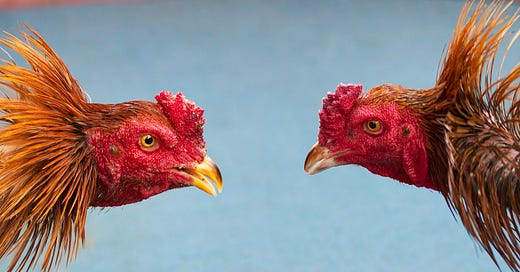Two examples:
In the novel The Day of the Locust the writer Nathanael West depicts a cock fight. By page 181 the smaller of the two birds is dying, but to revive it, the bird’s trainer1 does the following to the bloodied bird…
“Abe, moaning softly, smoothed its feathers and licked its eyes clean, then took its whole head in his mouth. The red was finished, however. It couldn’t even hold its neck straight. The dwarf blew away the feathers from under its tail and pressed the lips of its vent together hard. When that didn’t seem to help, he inserted his little finger and scratched the bird’s testicles.”
I read this passage in 1975, at the age of twelve, and have never forgotten it. Here the author combines tactile, step-by-step procedure to gain “head authority.” It’s clear West had paid attention at some cock fight. Better yet, the passage creates a sense of on-the-body physicality to give the reader a sympathetic visceral reaction. Licking the bloody eyes. Putting the head in his mouth. Scratching the bird’s internal testicles. Each action plants a new sensation in the reader’s nervous system.
That’s the type of brief, accurate description that a reader can’t unread.
A second example…
At the same age, twelve, I also read The Only Way to Cross, a history of transatlantic ocean liners,2 written by John Maxtone-Graham.
The author describes how important it was to bring daylight into the ship’s large public spaces. In the North Atlantic, weather kept passengers indoors more, so ship designers installed large skylights in the lounges and dining rooms. Picture the giant leaded-glass dome above the first-class stairwell in Titanic. During the day, these skylights brought even the dim sunshine in. But at night…
As Maxtone-Graham described it, at night those bright ceilings of glass became oppressive black voids. Due to the deck houses that protected them, the stars and moon weren’t visible. Worse yet, the cold night would chill the glass. All the humidity rising from throngs of passengers, that moisture would condense on the inside of the skylights and fall in fat, ice-cold drops onto the passengers.
People dancing or dining—especially women in low-cut dresses—steeled themselves for the inevitable trickle of ice water that would splat down the back of their necks or into their cleavage. When you picture all of those Edwardian rich people eating peacock tongues or waltzing about the Mauritania the Lusitania or the Titanic, know that they’re all dodging a constant “ice bucket challenge.” Such a detail adds a quirky new physical sense to such scenes, and gives the reader a distinct on-the-body way to perceive the goings-on.
A third example…
When I was thirty-one, my friend Alice taught me to make soap. She stressed that our hands had to be completely dry of perspiration. As we used the powdered lye, if even a stray grain of that lye found a spot of moisture on our skin it would immediately cause a chemical burn.
That’s where the chemical burn kisses in Fight Club come from. A practical physical process that teaches the reader something while also imprinting an on-the-body sensation. Thus, creating a moment you can’t unread.
In closing…
That’s what I want you to strive for. Please don’t overuse such moments, but know that they will burn their way into the reader’s memory for years to come.
Who is the little person referred to below as a dwarf.
I have always been a secret ship geek. In particular I love the Big Old Boats. During the ‘70s, the ocean liner emerged as a huge metaphor, from The Poseidon Adventure to Voyage of the Damned to Raise the Titanic, ship stories were all over.








“Dwarf takes cock in mouth and fondles balls” probably sounds a little strange on its own as a literary teaching excerpt.
Gnarly as hell and great. I've always like ships since reading of the Essex and then sailing the seas of Moby Dick.